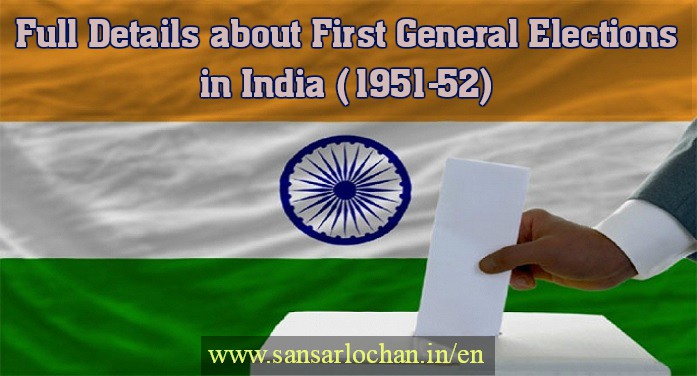First General Elections in India (1951-52)
India became a Sovereign Democratic Republic with the adoption of Constitution on 26th January, 1950. General elections to the first Lok Sabha as well as state assemblies were held from October 1951 to February 1952, on the basis of universal adult franchise. Thus India, with a far greater population than that of the USA, emerged as the world’s largest democracy.
The provision of universal adult franchise was a integral part of our constitution and a must thing for ensuring true democracy. The holding of general elections was a bold implementation of that constitutional provision.
World’s Largest Free Election
The first general election was the most gigantic political experiment in the history of democracy. The following facts indicate that it was the world’s largest free election.
- No. of seats in Lok Sabha for which elections were held – 489
- No. of electorate – 176 millions
- Number of persons who actually voted – 105.5 millions
- Total no. of Polling booths – 2,24,000
- % of votes polled – 45%
- No. of political parties in the fray-nearly 70
- No. of candidates who contested – 1800
Parties, Percentage of Votes and Seats
| Party | % of Votes | Seats |
|---|---|---|
| Indian National Congress | 45% | 364 |
| Communist Party of India | 3.29% | 16 |
| Bharatiya Jan Sangh | 3.06% | 3 |
| Akhila Bhartiya Hind Mahasabha | 0.95% | 4 |
| Scheduled Caste Federation | 2.38% | 2 |
| Independents | 16% | 37 |
| Kisan Mazdoor Praja Party | 6% | 9 |
Conclusion
From the results shown in the table given above, we can draw the following conclusions :-
-
- The Congress emerged as the most popular political party in the country. It had managed to bag 74.5% of the seats in Lok Sabha.
- The percentage of voting was 45%. It proved that the masses in India were politically conscious and understood the value of vote, though they were poor and illiterate.
- There was no relationship between the percentage of votes secured by a party and the number of seats won by it.
- The communists fared reasonably in Hyderabad, Travancore, Cochin, Tamil Nadu and West Bengal.
- Voting in rural areas was 60% and it was 40% in the towns.
- The entire election was conducted in a peaceful manner which was a notable and encouraging feature.
- The scheduled caste leader and the Chairman of the Drafting Committee of the Constitution Dr. B.R. Ambedkar was defeated from Bombay Constituency by a little known Kajrolkar.
Read all notes about the Indian Constitution here>> Indian Constitution
Source: NCERT, Gktoday
